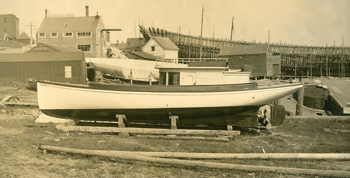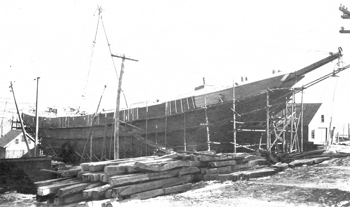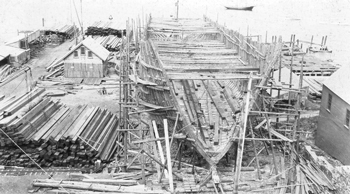Belfast Shipbuilders
Their Contributions to U.S. War Efforts
by Tom Seymour

Portion of the Pendleton Shipyard, Belfast, Maine. One of the last vessels in the process of being built. The sign on the roof of the building upper left reads, “Gasoline Engines and Launches”. Courtesy Belfast Historical Society and Museum
The Belfast Historical Society and Museum displays the following text regarding the USS Penobscot: “In 1861, the C. P. Carter shipyard built the gunboat USS Penobscot to government specifications in the record time of 90 days.
She was launched on November 19 and it was reported that she “glided from her ways like a thing of life and sat upon the water with swan-like gracefulness.” The Penobscot was first assigned to the North Atlantic Blockading Squadron and later served in the Gulf of Mexico where she was most successful in either destroying or capturing ships trying to run the blockades.”
For all the merchant and other vessels built in the great old shipbuilding city of Belfast, Maine, the steamer USS Penobscot was the first and only gunboat built and launched at Belfast. The vessel was built by the prolific Belfast shipbuilder, C. P. Carter according to a model and written specifications provided by the United States Navy Department.
Carter, a consummate builder and something of a perfectionist, spared no pains in acquiring material to build the Penobscot. Much of her oak timber was brought in from New Hampshire (white oak, the kind preferred by shipbuilders, was scarce in Maine even in 1862). When completed and opened for public inspection, a Belfast newspaper proclaimed that she was “pronounced the very best of the twenty-three boats that have been built” (presumably in Carter’s shipyard).
The Penobscot was solidly built, with an outside ceiling of six-inch oak plank and her sides up to the level of her upper deck were nearly two feet thick. The vessel’s length was 158 feet, the beam was 28 feet and she had a draft of nine feet, six inches. The USS Penobscot was powered by two, 200-horsepower engines, which turned a single screw-type propeller. These pushed the vessel along at a maximum speed of 11.5 miles per hour.
The USS Penobscot was fully armed, carrying one 11-inch Dahlgren smoothbore gun, two, 24-pound smoothbores and two, 24-pound Parrot rifles. Note that when gun and cannon nomenclature lists weights, it refers to the weight of the projectile, not the weight of the weapon.
Estimable Career
The USS Penobscot had a noteworthy career. After launching, she was delivered to the U.S. Navy at Boston on January 16, 1862. After being crewed and fitted out, she was assigned to the North Atlantic Blockading Squadron. Her task was to stop in any way possible, Confederate vessels attempting to break the blockade that the north imposed upon the south to keep the southern Confederacy from trading with other countries and thus, lengthening the war.

Winter, Matthews Shipyard, Belfast, Maine. One of the last ships built at the yard the Jennie Flood Kreger is being caulked. She was launched on March 3, 1919. Note caulker on upper forward starboard scaffolding. Courtesy Belfast Historical Society and Museum
The Penobscot’s first victim, the schooner Sereta, was forced aground and abandoned on June 8, 1862. Then on August 1 the Penobscot seized the sloop Lizzie and on October 22, she drove British ship Pathfinder aground and then destroyed her. That ended the Penobscot’s list of captured or destroyed vessels for the year 1862.
Then in 1863, Penobscot intercepted a Confederate steamer that was in the process of running the blockade off of Fort Fisher, North Carolina. During a brief exchange of fire, a shot smashed through ship’s surgeon, Dr. Edward Pierson’s stateroom, striking the doctor. Dr. Pierson succumbed to his wound several hours later.
Also in summer, 1863, while still on her regular patrol off the Carolinas, USS Penobscot forced Confederate blockade runner Kate ashore at Smith’s Island on July 12.
The following year Penobscot was assigned to blockading operations in the Gulf of Mexico, where she, along with other Union gunboats, sought Confederate blockade runners. In January, 1864, Penobscot joined others in providing support for union troops on the Matagorda Peninsula, troops who had disembarked for action against Fort Esperanza, a new Confederate fort near the end of the peninsula.
Penobscot, continuing on her patrols, seized British schooner Lily in the process of running the blockade. Lily was loaded with gunpowder meant for the Confederate cause. The day after capturing the Lily, Penobscot captured two schooners heading out to sea past the blockade. These were the Stingray and the John Douglas, both loaded with cotton.
Toward the end of her Gulf of Mexico effort, Penobscot captured the schooner James Williams.
Penobscot’s last wartime activity occurred on February 18, when she drove schooners Mary Agnes and Louisa aground at Aranas Pass. The following day, Penobscot sent one of her boats to the grounded schooners to destroy them.
Penobscot Decommissioned
The Penobscot sailed to New York at war’s end and was decommissioned there on July 31, 1865. Then on October 19, 1869, Penobscot was sold to Nehemiah Gibson at Portsmouth, New Hampshire.
In 1871, the Penobscot was rebuilt, refitted as a schooner and renamed Joseph w. Bartlett. The Bartlett was listed as a barkentine sailing out of Boston in 1878.
Wartime Barges
Coal was at a premium in New England during the early years of World War II. Those who burned coal for home heating often had to improvise or acquiesce to the cold.
The military needed as many seagoing vessels as it could get for the war effort. This put a crunch on hauling coal to New England. President Franklin D. Roosevelt himself devised the solution. As the president sat and watched a line of barges being towed up the Hudson River, he immediately envisioned the solution to New England’s coal problem. Have some of those old-time Maine shipbuilders build wooden barges. And so the government contracted with Maine wooden ship builders to produce barges for the war effort.

Matthews Shipyard, wood for the Jennie Flood Kreger, 1919. Location at the end of Main St., near current public landing. Courtesy Belfast Historical Society and Museum
Shipyards in both Belfast and Camden participated in the barge-building effort. Both towns answered the call and contracted with the United States Maritime Commission to build wooden barges.
Camden Shipping & Marine Railway Company was formed for the purpose of building wooden barges. Since barges were not typical of wooden vessels built in Maine, the company had to find a design. To that end, a half-model of a wooden barge built during the Civil War filled the gap. An architect drew plans based upon the half-model and President Roosevelt personally approved the plans.
The first of four barges built at Camden was launched on February 8, 1943. Although the 194-foot barge Pine Tree was ready to launch nearly a week earlier, the builders chose this day because that was when First Lady Eleanor Roosevelt was to visit Camden.
On the day of the launch, Camden was inundated with eager watchers as well as members of the press and also, movie makers. This was a gala event. Mrs. Roosevelt broke the traditional bottle of champagne across the bow and got splashed in the face with champagne for her effort. On hand to assist, though, was Maine governor Sumner Sewall. Governor Sewall handed the first lady a handkerchief to wipe the sparkling wine from her face.
Belfast, too, had her hand in this patriotic shipbuilding effort. The Belfast Shipbuilding Corporation contracted with the United States Marine Commission to build barges similar to those built in Camden. Prior to this, the last ship launched at Belfast was a 350-ton, double-deck, five-masted schooner built in 1919.
As in Camden, great crowds attended the launching of the first Barge, White Oak 1. But unlike Camden, First Lady Eleanor Roosevelt was not present and instead, Mrs. Ralph O. Brewster, a sponsor of the barge, performed the ceremony. However, the barge failed to cooperate and after moving only 12 feet, jammed on the ways, where it remained for nearly two more weeks. This required another bottle of champagne to be broken and Mrs. Brewster again did her duty. The bursting bottle soaked Mrs. Brewster, her husband, an ex-governor as well as several cameramen who stood a little too close to the ceremony.
Belfast also built White Oak II for the national government, but this time ample grease was applied to the ways and the vessel slid off without a problem.
Thanks to Belfast Historical Society and Museum for providing information and photographs used in compiling this article.
